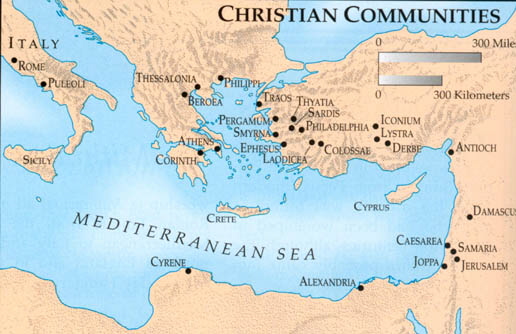Jewish Christianity: The first Christians were essentially all ethnically Jewish or Jewish proselytes. In other words, Jesus preached to the Jewish people and called from them his first disciples. (Matthew 10).
Pauline Christianity: Is a term applied to what some perceive as the religious teaching unique to Paul’s writings and specific from the gospel of Jesus. That is, Jesus distinctly taught one thing, and Paul noticably taught something completely different. Those who believe in a separate Pauline Christianity believe that the Christianity of today has little to do with Jesus’ teachings; rather, it is the product of Paul’s corruption of those teachings.
Gnostic Christianity: In most Gnostic systems the sufficient cause of salvation is this "knowledge of" (or the "acquaintance with") the divine. It is an inward "knowing," comparable to that encouraged by Plotinus, and differs from Christian proto-Orthodox views.
Christianity originated in Roman-occupied Jerusalem, a predominantly but not entirely Jewish society, with traditional philosophies distinct from the Classical Greek thought which was dominant in the greater Roman Empire during that era of time.
 In the first few centuries after Christ was crucified there was no Roman Catholic Church. There was a catholic church but not a Roman Catholic Church. The word "catholic" simply means universal. In the time of the Roman Empire there were various locally governed and administered churches. For example, there was the Church of Jerusalem, the Church of Rome, the Church of Antioch, the Church of Alexandria, the Church of Corinth, etc. Each of these churches was ruled separately by their own bishops. The bishop of one church had no authority over the bishop of another church. But the Christians in all these churches considered themselves to be one spiritually even though they were governed separately.
In the first few centuries after Christ was crucified there was no Roman Catholic Church. There was a catholic church but not a Roman Catholic Church. The word "catholic" simply means universal. In the time of the Roman Empire there were various locally governed and administered churches. For example, there was the Church of Jerusalem, the Church of Rome, the Church of Antioch, the Church of Alexandria, the Church of Corinth, etc. Each of these churches was ruled separately by their own bishops. The bishop of one church had no authority over the bishop of another church. But the Christians in all these churches considered themselves to be one spiritually even though they were governed separately.
The Christians in these various churches did not see "eye-to-eye' on every doctrine. They differed on matters of secondary doctrine, as Christians do today, but they all were in agreement with the primary and essential doctrines concerning the Deity (God).
Crucifixions were also common in the Roman Empire. They were so common that the crucifixion of Jesus of Nazareth was noticed only by a small group of dedicated followers. To understand the life and death of Jesus and the birth of Christianity, one must understand the context of the Roman Empire.
Christianity was adopted and imposed (325 AD) by Emperor Constantine as a replacement for all the diverse religions then recognized and practiced in the Roman Empire. With Christianity as the official and only state religion, the wealth and property of all the other religions were swept into the Roman treasury.
Christian history shows that the Holy Spirit has made sure through the centuries that all Christians agree on the essential or primary doctrines concerning the Person and work of Jesus Christ. On matters of secondary doctrines Christians have differed and continue to do so. However, some Christians believe the knowledge [or lack of knowledge] of these secondary doctrines do not affect one's salvation, but do affect one's better understanding of God.
Wikipedia definition - A Christian denomination is a distinct religious body within Christianity, identified by traits such as a name, organisation, leadership and doctrine. Individual bodies, however, may use alternative terms to describe themselves, such as church or sometimes fellowship. Divisions between one group and another are defined by authority and doctrine; issues such as the nature of Jesus, the authority of apostolic succession, eschatology, and papal primacy may separate one denomination from another. Groups of denominations—often sharing broadly similar beliefs, practices, and historical ties—are sometimes known as "branches of Christianity" or "denominational families".
The history of Christianity concerns the Christian religion, first referred to as Christendom, and the Church with its various denominations, from the 1st century to our present age. Roman Catholic and Eastern Orthodox Christianity spread to all of Europe in the Middle Ages... Protestantism made it's grand entrance in the 16th century and Evangelism surfaced in the 18th century. Today there are more than two billion Christians worldwide, and remains the world's largest religion.
Related Topics:
The Basic of Christian History
What Were Early Christians Like?
Early Christianity, An Introduction
Related Topics:
The Basic of Christian History
What Were Early Christians Like?
Early Christianity, An Introduction
No comments:
Post a Comment
Thank you for your feedback!